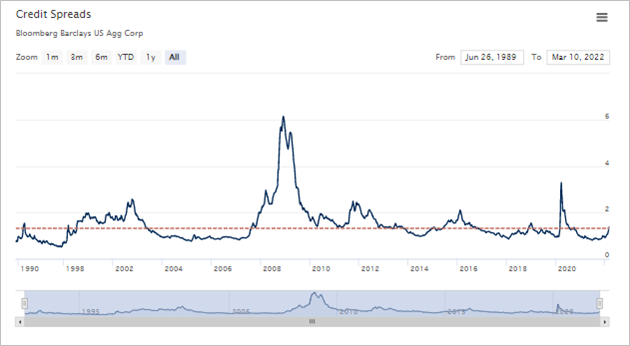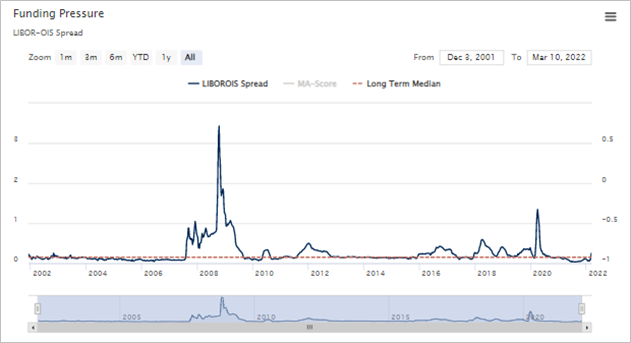When taking asset class views, we consider a combination of four factors: Valuations, Economics, Financial Conditions and Sentiment. Financial conditions are a driving factor at present and from this perspective, some of the factors we look at are Monetary Policy, Credit Spreads and Funding Pressure. These give us an indication of whether the environment is accommodative or restrictive.
Credit spreads rise but not out of the ordinary
The chart below shows that although Credit Spreads are picking up, they are just above the long-term median, and historically they are not anything out of the ordinary. Central banks in developed markets are well equipped to prevent credit market volatility from affecting the credit supply as they are well-capitalised and have the reserves if they need to intervene. They did so in 2020 and their actions prevented a credit crisis. Thus, most indications are that risks to global credit and money markets are currently subdued.

Source: Bloomberg
Risk of interbank default rises above long-term median
Where we are seeing bigger moves in Financial Conditions is in the Funding Pressure factor where the perceived risk of default in the interbank sector has risen. In the chart below, we see that Funding Pressure has risen further above the long-term median.

Source: Bloomberg
What is keeping Financial Conditions out of absolute restrictive territory right now is an accommodative Monetary Policy. Our views reflect what is happening in the economy at present and we cannot predict what further impacts the war will have unless it is detected in the data that feeds into our models daily.
The Fed is determined to fight rising inflation. The expectation of a 50-basis point (bp) rate hike in March has adjusted to 25 bps, with Fed chair Jerome Powell effectively taking a 50-bp hike off the table. Interest rates are still expected to rise, even though the Ukraine war is clouding the outlook for global economic growth. A lower-for-longer thesis will most probably come back into play, which will still attract investment in fixed interest assets.
Speculation often gets ahead of economic facts
The rotation from risky assets into safe-haven assets is to be expected during a crisis. Investors have historically sold out of equities and into bonds and commodities. Sentiment-driven overreactions are part of the human biases we aim to eliminate from our investment decision-making process. It is these reactions that create the opportunities we look for. Statistical evidence suggests that a contrarian approach can lead to outperformance at times where speculation gets ahead of economic facts. While we cautiously monitor the situation, there is currently no hard economic data pointing to a deeper economic impact, globally.
European equities still attractive
European equities have become more attractive due to improving valuations and supportive economics measured by positive economic surprises, low unemployment, high profit margins and high economic activity in core European markets. It’s vital here to not be heavily influenced by overly pessimistic bear cases presented by the market.
Emerging market bonds present value
US dollar-denominated emerging market bonds are more attractive, given that relative yields versus peers are higher and market perceived risk is higher, which is positive for risky assets such as emerging market bonds in comparison to safe-haven assets such as US bonds.
The rand still offers attractive carry trade opportunities
Looking at the rand, carry trade opportunities are more attractive as the real interest rate differential increases. Real yields in US bonds are low on the back of high inflation in the US. If inflation rises, real yields will drop further. The more the market moves toward US bonds, the more the price rises, and yields drop. As a result, the SA versus US 10- year real interest spread will rise.
As always, we remain guided by insight and informed by science. Although the market is very volatile now, it has never been our approach to react without clear evidence of material changes in our data and models. DM/BM
Author: Shriya Roy – Quantitative Analyst, Prescient Investment Management

Disclaimer:
- Prescient Investment Management (Pty) Ltd is an authorised financial services provider (FSP 612).
- The value of investments may go up as well as down, and past performance is not necessarily a guide to future performance.
- There are risks involved in buying or selling a financial product.
- This document is for information purposes only and does not constitute or form part of any offer to issue or sell or any solicitation of any offer to subscribe for or purchase any particular investments. Opinions expressed in this document may be changed without notice at any time after publication. We therefore disclaim any liability for any loss, liability, damage (whether direct or consequential) or expense of any nature whatsoever which may be suffered as a result of or which may be attributable directly or indirectly to the use of or reliance upon the information.


















Comments - Please login in order to comment.